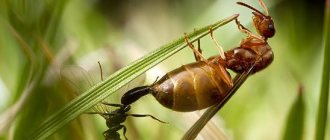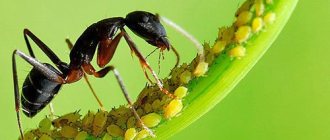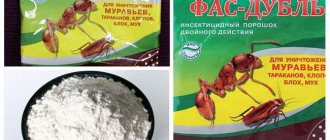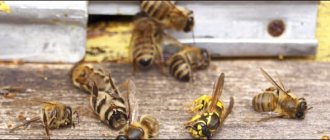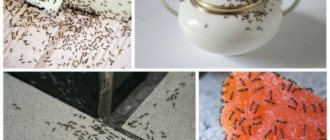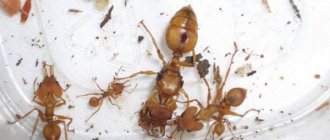Enemy classification
Despite the fact that insects bring great benefits in nature, their populations cause considerable harm to the crop, as well as to humans themselves.
They clean the forest, loosen the soil, pollinate plants and process waste. The ant itself is an invaluable source of carbohydrates and proteins, so for many animals this species is a real delicacy. In nature, there are many representatives of the animal world who prefer to feed on these tiny insects.
Enemies of ants are conventionally divided into 2 types:
- Internal. They enter the body of insects in various ways or are able to live with them in the same territory.
- External. These include representatives of the fauna that use ants as food.
Why are ants useful?
Ants provide aeration and soil movement in tropical and temperate forests. Many species of these insects loosen, mix and fertilize the soil. In areas with hot and dry climates, they increase yields.
Many species of ants are an important link in the food chain - they serve as food for many animals. In addition, individuals settling in dead wood participate in its mechanical destruction, thereby accelerating decomposition.
It is thanks to ants feeding on plant seeds that many species of flora successfully spread. For example, violet, hoofweed and woodland spread exclusively thanks to ants. These are the only insects capable of dispersing plant seeds in huge quantities, in all ecosystems and on all continents.
Ants are also record holders for capturing carbon dioxide from the atmosphere. Thanks to these insects, chalk, marble and limestone are converted into magnesium and calcium carbonate 50-300 times faster.
Ants are active predators. They destroy many insect pests. Among them are false caterpillars and caterpillars. And in China, weaver ants are actively used in growing citrus fruits - they help fight pests.
In South Africa, ants are used to harvest rooibos bushes (herbal tea). The fact is that during the fruitful period, rooibos scatters its seeds quite far. And black ants collect them and store them in a nest, from where people take them. One anthill contains up to 200 grams of seeds.
Medicinal ant bites
Ant bites can cause unpleasant consequences in some cases. But despite this, in medicine they are considered healing. It's all about formic acid. It contains zinc complex - an excellent antioxidant and immunostimulant. Among other things, formic acid protects the body from chronic diseases, atherosclerosis and the negative effects of free radicals.
Treatment procedure: you need to find an anthill in the forest, undress to your underwear, plug your ears with cotton wool, lower a prepared birch broom into the anthill and let the ants climb onto it, and then transfer the insects to yourself. The procedure is usually carried out for five minutes, after which all ants must be carefully shaken off. Complete the procedure with a warm shower.
It is important not to forget: the bites of some types of ants can cause anaphylactic shock and allergies. Before starting treatment in this way, you should check what type of insects will be involved in the procedure and monitor the body’s reaction to their secretion.
Natural enemies of termites
Who in nature feeds on termites depends primarily on what country and what climate we are talking about. In the tropics and Africa, there are species of spiders, lizards, insects and even mammals whose diet is almost entirely focused around termites. Such animals are called termitophages. There are many more animals, in whose menu termites are only one of the dishes. In the south of Russia this could be:
- Any kind of birds
- Bees
- frogs
- Centipedes
- Crickets
- Dragonflies
- Snakes
- Cockroaches
- The bats
- Foxes
- The Bears
- Mice
However, the worst enemies of termites are ants. It is for protection against them that a caste of soldiers is mainly created in termite mounds. Ant attack tactics and termite nest defense tactics can be so elaborate and strategically complex that reading about it makes it hard to believe that insects are actually capable of developing such a clever campaign. In fairness, it is worth mentioning that there are also those types of termites that themselves hunt ants and destroy their nests in no less intricate ways.
Hierarchy in an anthill
An anthill is a kind of society, almost democratic, in which everyone does their job depending on their status:
- Workers or foragers are required to deliver food, take care of all residents and protect their home from enemies; ants eat what they find when searching for food, as well as supplies in the colony itself.
- Queens - female ants that lay eggs, feed on the most delicious and necessary protein food.
- Males are intended to mate with a female, after which they die.
- The larvae are divided into 2 groups: some feed themselves, others need constant feeding, which is what all adults do, specially preparing food for them. Depending on the diet of the larvae in the future, after pupation, they become either workers or queens for the production of offspring.
What do ants eat? Nutrition in natural conditions
Most ant species are omnivores. They can be content with both plant food: fruits, seeds, vegetative parts of plants, gum and tree sap, and food of animal origin. Special products include unfertilized eggs, which the queen lays in difficult times to feed her relatives.
Harvester ants feed primarily on seeds. Most often, representatives of this genus live in arid areas, where it is difficult to get food during the absence of rain. Therefore, at favorable times, they collect seeds and store them in their nests. There are known cases when more than a kilogram of seeds were found in one anthill!
This food is very hard and needs some processing. Therefore, the warrior ants grind the seeds with their powerful jaws, turning them into an edible pulp.
Among these insects there are also those that eat ants. These are dangerous predators, whose food can also be:
- various insects, their eggs and larvae;
- arachnids, centipedes and other invertebrates;
- small reptiles;
- amphibians;
- little chicks.
Many of them do not disdain carrion, and are also capable of attacking mortally wounded large mammals.
There are species with a narrow food specialization. For example, the Dracula ant hunts spiders, feeds them to its larvae, and after that the adults suck the juices out of them. Centromyrmex settle in termite mounds and eat their inhabitants. Myrmecophages feed on other ants. And the main food of exotic bulldog ants are wasps and bees.
Within the colony, ant nutrition is subject to a certain hierarchy depending on the functions performed:
- The queen receives the most nutritious food;
- the larvae are fed mainly with proteins, as they need this for growth and development;
- worker ants and soldiers require an easily digestible carbohydrate menu from plant juices, fruits, pulp and plant seeds.
"Cash Cows"
Wood ants feed mainly on honeydew - sweet secretions from the bodies of aphids and other insects. Therefore, they keep them as a kind of “herd”: “graze” them, protect them, transfer them to new “pastures” (plant areas), and for the winter they take their “cash cows” to special sections of the anthill.
All foragers (ants responsible for delivering food to the family) have their own responsibilities:
- “shepherds” look after the aphids and force them to secrete a sweet liquid by tapping them with their antennae;
- “transporters” carry droplets of honeydew in their crop to the nest;
- “guardians” protect aphids from ladybugs and other predators;
- “scouts” are looking for new colonies of insects.
If the milk yield is very large, guardian ants “store” it in their crops. Some species have individuals that store so much sweet food that they cannot move. These are the so-called “honey barrels”. They sit in the nest and feed their relatives.
Mushroom cultivation
About 200 species of ants are capable of growing their own food. They use the remains of their victims and feces as a substrate for cultivating fungi.
Leaf-cutter ants have adapted pieces of leaves for this. Large individuals with powerful jaws specialize in gnawing leaves, smaller ones specialize in chopping them, and the smallest ones take care of myceliums.
Insects eat only hyphae—thread-like structures of fungi, preventing them from forming fruiting bodies.
Wildlife - who warns insects
All latitudes are characterized by the bloodthirstiness of the natural habitats of insects. Forests, clearings, steppes, banks of reservoirs - processes of eating each other take place everywhere. Ants are no exception in this chain.
Despite their small size, as well as their place of residence underground, they are always found.
Who considers ants a delicacy in the wild:
Bear
Although bears don’t really like to eat ants, if they are very hungry, then they don’t have to choose. They hunt as follows: the bear puts its claws inside the anthill, after which it licks off the insects that get there.
Jerzy
Hedgehogs, like mice, are quite omnivorous, so if they come across an anthill on their way, they can have a light snack.
Spiders
In rare cases, insects become food for spiders, but this can be considered the exception rather than the rule. This is explained by the fact that they are rarely caught in nets, and the spiders themselves try to avoid encounters with them, since their bodies contain acid that is strong enough for them.
Fish
Along with the rain, small debris, soil, leaves, grass and, of course, various insects are washed into the water, which immediately become prey to fish.
frogs
The main diet of the amphibian is considered to be the consumption of flies and mosquitoes. But in order to diversify their menu, sometimes they eat ants, and they catch them using their usual method - using their tongue.
Internal enemies of ants
The internal enemies of the ant population include some types of fungi, insects and helminths:
- Mushrooms of the genus Cordyceps infect, kill the insect, and the fruiting bodies of the fungi sprout from its body.
- Fanwings are insect parasites that use ant individuals to attract partners during mating.
- Humpback flies lay eggs in the body of a living individual. The developed larva decapitates the insect using a special enzyme.
- Blueberry butterfly larvae develop in ant nests. Caterpillars secrete the same odorous substances as ant larvae. Therefore, ants take care of them, and caterpillars feed on their pupae.
- Lomechusa beetle - with the help of a secreted drug, this parasite forces insects to feed and care for it more than for their offspring, and the anthill degenerates.
- The parasitic wasp Aphylanthops feeds its larvae with insect wings.
Who wouldn't mind eating ants in the garden?
Many people now think that in the garden they are met by the same enemies as in the wild, but if you think about it, how often have you met bears or fish passing by in your garden?
Even if we talk about hedgehogs, they also try to stay as far away from people as possible. Therefore, we can conclude that a garden plot and a field/forest are different risk zones for insects. Let's take a closer look at the main enemies.
Birds
Yes, you’ll say now, why don’t they eat ants in nature? They become a source of their food, but not so often and not in such large quantities. You can note a large number of birds in the summer cottage immediately after the beds were processed, since the anthills were damaged, and their inhabitants themselves were running around on the ground in search of shelter and food.
It is in these cases that the birds become attack aircraft, diving into the ground, they begin collecting prey. Most often, they are chosen by small birds (for example, sparrows), since it is easier and better for large ones to get something large. It is also worth noting that ants become prey for woodpeckers. The woodpecker collects them while processing trees.
Lizards
Lizards are considered one of the most terrible connoisseurs of ants. If we talk about wildlife, then their menu is more varied, but the garden cannot boast of such an abundance of crawling/flying insects.
They successfully catch ants on open surfaces, as well as inside greenhouses, in recreation areas, sometimes even inside living quarters. They prefer to eat to their fill at one time (they destroy a large number of individuals), and then rest and be lazy, basking in the sun.
Moles
If we talk about the main diet of the inhabitants of the underground “kingdom”, they prefer worms and larvae. But if we talk about a delicacy for them, then this is definitely an ant.
They do not often look for an anthill in order to profit, but if they come across one on their way, then only a few individuals will remain among the living. And don’t underestimate moles, because they are only seemingly slow; when they hunt, they become real cheetahs.
Antlion
Antlions are quite nasty insects for humans; they specialize in small prey that live inside burrows, similar types of shelters. Most often, these predators simply wait for their victims near the entrance to the home.
They are distinguished by lightning-fast attacks; antlions swallow insects alive whole. But it should be noted that they are not so willing to look for ants; most often, they become their source of food while hunting for another type of living creature - spider, aphid, grasshopper.
As you can see, ants can be considered unfortunate insects that many people want to eat. At the same time, these insects themselves are not averse to hunting, for example, with a large accumulation of the family, they “overwhelm” large spiders, while managing with minimal losses.
This is a spectacular spectacle, somewhat reminiscent of ancient people hunting mammoths. But this can be seen very rarely; much more often, ants are lunch for the most agile inhabitants of the macro- and microworld.
Who eats ants in the middle zone
The most important anteater in our area is the clubfoot. The beast calmly destroys the anthill and licks hordes of goosebumps and their larvae from its furry paws. It’s not for nothing that people have a saying: you can’t feed an ant to a bear.
Moles and shrews, bumping into ant passages, destroy the little workers. But insects are not their main source of food. For animals, arthropods serve as a light snack.
On a note!
Rodents living in the forest can also feast on a passing ant, but they do not destroy anthills because they are afraid of numerous ant bites.
The frog eats ants along with other insects. She catches the hard worker with her sticky tongue and quickly swallows him.
Birds in gardens and forests feed on ants:
- sparrows;
- wrens;
- hazel grouse;
- wagtails;
- Bluethroats.
Woodpeckers are famous anteaters. They can smell the bugs hidden in the bark. The bird sweeps out the “forest orderlies” with its feathers and begins to quickly eat them.
Photo of ants wintering
When the snow melts and the top layer of the home gets wet, the ants quickly drag supplies deeper into other compartments. For these purposes, the ant colony has a special detachment. The majority of ants sleep in winter. Their organs work very slowly. A certain part of the family is active, although at a slower pace. They monitor order, supplies, and the strength of housing. Although the ant loves warmth, it can withstand frost down to -50C. This is because a lot of sugary substance accumulates in his body.
In order not to deprive themselves of their favorite treat for the long winter months, ants carry aphids into their chambers to eat the sweet honeydew. True, without fresh food, aphids cannot survive the entire season and die, but for some time they delight their caring owners with tasty secretions.
Who eats ants in the tropics
The insects living here have developed more serious means of defense. Their stings contain poison, and their mandibles tightly cling to the skin of the enemy. But enemies of ants live here too.
The most famous anteater in the world. It belongs to the large anteater family. Each species belonging to this family feeds on hard-working arthropods:
- a giant anteater destroys ground anthills;
- the dwarf hunts mostly termites;
- The four-legged anteater can get goosebumps both on the ground and on a tree.
The body structure of these animals is adapted to destroy ants. Wide paws rake the nest, tough fur protects against bites, and a sticky tongue helps catch many bugs.
Interesting!
The anteater has poor eyesight. He searches for insects by smell.
In the tropics, anteaters are not the only animals that eat ants. They are also hunted by other animals:
- armadillos;
- wryneck;
- antbird;
- woodpecker.
The woodpecker, which lives in the Himalayas, catches ants with the help of a sticky tail, the feathers of which are stuck to their heads. The plumage of the bird itself is covered with foul-smelling resin.
An antcatcher is a bird that cannot fly. She deftly runs on the ground and hunts insects crawling on the ground.
There is even an anteater fish called the splasher. It knocks prey off the foliage with a short, sharp stream of water.
Although there are plenty of different hunters in nature, ants continue to be the most common on the globe. All this is thanks to a lifestyle where each individual works for the benefit of the entire family.
External
External enemies of ants
Among the animal world, there are plenty of lovers who are not averse to feasting on the strongest insects. In addition to the well-known variant of the anteater, there are many other admirers of these insects. Among the animals they eat, ants are:
- Ant-eater. The anteater is enemy number one. These individuals are the main source of food for him. The anteater detects and eats ants using a specially shaped nose and tongue. He tears the anthill with his front paws, after which he lowers his tongue into the nest. The presence of numerous spines on the tongue allows you to capture a large number of ants at one time. Anteaters do not have teeth and they have horn-like growths in the stomach area that are responsible for grinding food.
- Bear. Not only brown, but also many other varieties. They deftly tear apart the anthill with their huge paws and quickly eat small individuals. Even the larva is to the taste of the shaggy owner of the forest. He does not have such a long nose and tongue as an anteater, but this does not stop him from feasting on small ants.
- Jerzy. They love to eat a wide variety of small six-legged animals, including ants.
- Frogs and toads. In most cases they feed on small membranous fish. These individuals have one of the characteristics of the anteater - a long tongue, with the help of which it is convenient to obtain food.
Anteater - description, structure. What does an anteater look like?
The sizes of anteaters vary depending on the species, so the largest giant anteater reaches two meters in length, and what is interesting is that half of its size is in the tail. Its weight is approximately 30-35 kg.
The smallest dwarf anteater is only 16-20 cm in length and weighs no more than 400 grams.
The anteater's head is small, but very elongated, and its length can be 30% of the length of its body. The anteater's jaws are practically fused together, so it is impossible for him to open his mouth wide, however, he does not need to do this. Like having teeth. Yes, anteaters literally have no teeth at all, but the lack of teeth is more than compensated for by the anteater’s long and muscular tongue, which stretches along the entire length of their muzzle and is a real source of pride for this animal. The length of the giant anteater's tongue reaches 60 cm, this is the longest tongue among all living creatures living on Earth.
The eyes and ears of anteaters are not large, but their paws are strong, muscular, and also armed with long and curved claws. These very claws are the only detail of their appearance that reminds of their relationship with sloths and armadillos. Anteaters also have a well-developed charm and can smell potential prey.
Anteaters also have rather long and, moreover, muscular tails, which have a useful application - with their help, anteaters can move through trees.
The giant anteater has long fur, especially on its tail, which gives it a broom-like appearance. But in other species of anteaters, the fur, on the contrary, is short and stiff.
Anteater diet
The diet of these mammals consists exclusively of social insects, primarily ants and termites, and such a diet requires adaptations not only of the chewing apparatus and digestive tract, but also of behavior, metabolic rate and mode of movement. The giant species eats large-sized ants and termites, the tamandua eats medium-sized ones, and the dwarf species specializes in the smallest. Tamandua, for example, usually eats up to 9 thousand ants per day, and a giant one can eat 30 thousand ants per day.
These animals are picky and avoid swallowing soldier ants, as well as ants and termites that have chemical defenses.
Anteaters usually do not drink, but are content with the water they receive with their food.
The method of food absorption is unique among mammals. Anteaters contract their chewing muscles in order to turn out the halves of the lower jaw, and thus open their mouth. The mouth is closed by the pterygoid muscles. The result is simplified and minimal jaw movement consistent with the inward and outward movement of the tongue. This technique allows for almost continuous swallowing and maximizes the rate of food consumption. These movements of the tongue are controlled by a special muscle that is attached to the base of the sternum.
Another unique feature of anteaters is the absence of hydrochloric acid in the stomach, which should help digestion. And it is replaced by formic acid from food.
All anteaters have a low metabolic rate, and the giant representatives of the family have the lowest body temperature among placental mammals (32.7 ° C). The body temperature of the tamandua and the dwarf species is slightly higher.
Interesting facts about anteaters
- A typical voracious anteater can eat up to 30 thousand ants or termites in a day.
- Anteaters are not herd animals; they prefer to lead a solitary lifestyle, at most a family one. However, when in captivity they can play well with each other.
- Anteaters have a peaceful nature, which makes them amenable to domestication; they can get along well with more common pets: cats and dogs, and even love to play with children. True, keeping an anteater at home is not so easy, because they cannot stand the cold at all; the favorable temperature for them should be no lower than 24-26 C.
- Anteaters, among other things, are good swimmers and can easily swim across tropical bodies of water.
Soldier ants. Ant "super soldier"
ant "super soldier"
Although all ants of the genus pheidole, thanks to their genetic material, can become “super-soldiers”, nevertheless, such “castes” are rarely found in nature.
The “super soldier” ant has a huge head that blocks the entrance to his home, while he fights for it like no other. Only two species of this genus are capable of developing naturally. However, researchers have discovered that all Pheidole ants have genetic material that helps develop a "super ant". The study showed that all such ants had a common ancestor, who passed on the corresponding gene to them.
It is obvious that such super-ants hereditarily acquire something that appears quite rarely within their species, and then by chance. To understand why super ants are such a rare phenomenon, the researchers combined analysis from field studies, hormonal manipulations, gene expression analysis and a phylogenetic tree of dinosaurs and birds, which shows the evolutionary relationship between the species and their common ancestors.
Larvae are laid in equal proportions by the "queen", however, environmental factors determine which caste is born. “When the queen lays her eggs, depending on the temperature, either a queen or a worker is born. At the same time, nutrition also influences which caste the newly born will subsequently belong to,” says Ehab Abouheif, author of the study published in the journal Science. Experts have also discovered that the development of super soldiers can also occur in the form of Pheidole morrisi, this occurs with the help of a special hormone in the larvae. Thus, external stimuli can also activate super soldier genes.
Most species of ants in the genus Pheidole have two types of castes other than the queen: workers and soldiers. The workers do most of the work inside the nest, while the soldiers “cooperate” with each other outside it, they perform a protective function. They also use their large jaws to crush seeds that the worker ants collect. This genus of ants is the most numerous, with about 1,100 species around the world.
Where does the anteater live?
Like their other relatives from the order of edentates, anteaters live exclusively in Central and South America, especially many of them live in Paraguay, Uruguay, Argentina, and Brazil. The northern border of their habitat lies in Mexico. Anteaters are heat-loving animals and, accordingly, live exclusively in places with a warm climate. They like to settle in forests (all anteaters, with the exception of the giant one, easily climb trees) and grassy plains, where many insects live - their potential food.
Where do ants hibernate and how does it happen?
Ants begin preparing for the winter cold long before the onset of the cold weather itself. This is a labor-intensive, important process and takes a lot of effort and time from little fussy workers. It is necessary not only to insulate the home, but to stock up on enough food and “put all the offspring back on their feet.” Some species do not sleep in winter. It is their responsibility to monitor the cameras, repair and strengthen them as necessary.
The main concern of insects is to prepare abundant supplies. To do this, caterpillars, insects, seeds, etc. are used. It is necessary to check the existing chambers of the anthill, repair them, dig new ones, if there is such a need. All supplies must be neatly and evenly stacked to avoid spoilage.
The second, but no less important task is to feed the larvae before the onset of frost. Before the winter season, their mass maturation begins.
During the winter, ants do not leave their homes, they only move to deeper compartments. The microclimate there is warm and stable
And this is important for a heat-loving insect. The cold has a detrimental effect on him.
Entrances and exits from the anthill are carefully and hermetically sealed. Clay, earth, dead wood from grass and flowers are used. When there is a thaw, small holes will open for ventilation, and then become clogged again.
Types of anteaters, photos and names
As we wrote at the beginning, there are three types of anteaters in nature, and further we will write about each of them.
Giant anteater
The largest representative of the anteater family, living in South and Central America and also the only one of this family that, due to its large size, is unable to climb trees. Leads a predominantly nocturnal lifestyle; when walking, it characteristically bends its legs, resting on the back of the forelimbs. A means of protection against predators are sharp claws on powerful paws.
Pygmy anteater
On the contrary, it is the smallest anteater living in the tropical forests of South America. The pygmy anteater can climb trees very well; moreover, trees are a safe refuge for it from predators. Like other anteaters, it feeds on small insects, ants, termites, and is nocturnal.
Tamandua anteater
He is also a four-toed anteater, lives in Central America, and there are also especially many of them in southern Mexico. It is relatively small in size, larger than the dwarf anteater, but much smaller than the giant one, its body length is up to 88 cm, weight - 4-5 kg. Just like its dwarf relative, tamandua climbs trees well; according to the observations of Venezuelan zoologists, it spends from 13 to 64% of its life in trees. He has poor eyesight, but has excellent charm, and uses his sense of smell to find his favorite prey, ants and termites.
Interesting fact: the Amazon Indians long ago domesticated the tamandua anteaters, which have been used since ancient times to fight ants and termites in their homes.
What do ants eat in nature?
Ants can be predators, scavengers, and consumers of plant food. The food of almost all varieties of this order of insects consists of protein and carbohydrate components. The source of protein food is insects, which adults hunt or collect their carcasses. The source of carbohydrate food is:
- honeydew - a sweet substance secreted by aphids and other proboscis insects;
- Honeydew is a sticky, sweet liquid secreted by leaves as a result of a sharp change in temperature.
Many species of ants have food specialization. For example:
- ponerines - feed on a certain type of invertebrate;
- Centromyrmex (stinging ants) – eat termites;
- red fiery ones - hunt other ants and insects: weevils, moths;
- bulldogs - hunt bees;
- wood borers - collect gum (frozen sap from tree bark);
- myrmicines, harvester ants - almost 97% of their diet consists of seeds;
- Draculas - feed on the juices of their larvae, and the larvae are fed with insects: centipedes, spiders;
- stray or prickly - eat animal food: all kinds of insects and larvae, attack frogs, chicks, small lizards, collect carrion;
- Mexican honey - workers store in their swollen abdomens a liquid sweet substance reminiscent of honey. If necessary, they regurgitate it and feed this food to their fellow tribesmen.
About 190 species of ants breed and consume mushrooms, for example:
- leaf cutters Atta and Acromyrmex - feed only on the hyphae of fungi growing near their nest. To grow mushrooms, pieces of leaves are used, which are crushed by insects and placed in mushroom gardens;
- fungus growers and leaf cutters Attini - breed mushrooms in a nest, growing them on the leaf mass they themselves processed;
Often, in addition to the owners, other residents live in an anthill: beetles, caterpillars, moths. The ants feed them, and in return they eat the sweet syrup that they secrete. For example, the diet of red forest ants consists of honeydew by 60%, so they breed aphids, protect them, and take them with them to the anthill in winter. There is no waste in nature, no harmful or beneficial organisms. Plants are food for mammals, insects, and birds, which return substances necessary for the growth of new plants to the soil.
Ants are tenacious. Not all chemicals “take” them. Even slippers with a weak blow can be powerless - the thick chitinous layer is too strong.
But ants cannot be called immortal - they have many natural enemies who happily eat multi-legged pests. Moreover, insects are not immune from meeting them either in the wild or in the garden. Who are these saviors of summer cottages, and sometimes apartments?
Enemies in the garden
Anthills located within the garden can also be attacked by all kinds of insects and animals. The danger of these insects lurks even from the air.
Birds
Birds help gardeners by saving them from aphids, midges and caterpillars. Both worker ants and queens that have left their native anthill can also fall into their tenacious paws.
Moles and shrews
As a rule, they overtake their prey underground. While building another “tunnel”, they can feed on both larvae and adults.
Lizards
They can overtake the victim anywhere: even in a garden bed, even in a closed greenhouse.
Antlion
It waits for small insects near its lair, be it an aphid, a spider or an ant.
As you can see, the poor ants have plenty of enemies. Moreover, sometimes even pets - cats or dogs - cause damage to the anthill. However, these insects still remain the most numerous, famous and ubiquitous. Therefore, you can easily stumble upon hills of anthills both in the forest and in the city center - in a sandbox, an old stump or a flower bed.
Internal enemies
Internal enemies of ants
Internal enemies pose no less of a danger to the ant population. They enter the insect's body in various ways, but as a result, numerous colonies die.
- Cordyceps mushrooms. After entering the body of an ant, it is killed and new fruiting bodies are born from the body of the killed one.
- Humpback flies. They lay eggs in the body of an insect.
- Lomechusa beetle. Releases a special drug, under the influence of which the entire colony begins to take care of its offspring.
- Wheelwings. They use the insect to attract a sexual partner.
- Saprophytic mites that parasitize ants
Thus, the smallest strongmen have enough enemies among animals and even plants. In addition to anteaters, which live in American latitudes, there are plenty of ant lovers in our country. Therefore, in order to preserve their populations, nature has endowed them with the ability to reproduce quickly and have excellent adaptability to new living conditions.
Ants are the superfamily Antidae, order Hymenoptera, the most numerous species of living beings on Earth. Unique adaptability to different temperature conditions and territorial conditions allows ant families to inhabit all sorts of places.
Ant representatives of insects are omnivores and perform many functions in nature:
- enrich the soil with microelements;
- pollinate plants, spread seeds;
- recycle waste;
- They eat pests of forests and vegetable gardens.
What to do to prevent ants from getting in
Ants enter an apartment or private house in search of food or shelter from cold and rain. You need to start fighting them by finding a nest. This is where you can find an ant family. The fight against ants should include the following steps:
- pour boiling water over the nest, keeping in mind that the water is unlikely to reach the queen;
- clean your home and treat all surfaces with a disinfectant;
- seal all cracks and cracks in the floor and walls;
- treat the ant paths with anti-ant gel (Combat, Global, FAS, Dohlox), spray a spray near the anthill (Raptor, Raid, Dichlorvos) or place traps in places where parasites accumulate.
The best remedy for domestic ants is hygiene, timely cleaning, and minor repairs (insects often live in floor crevices, adobe walls, and cracks). Do not leave food or bread crumbs on the table. It is better to take out the kitchen bucket regularly to deprive insects of their food supply.
How to get rid of ants in an apartment forever?
Dirty dishes and the presence of food residues lead to the fact that small black ants may appear in the apartment in winter or summer. To get rid of them, you need to use special products - commercial chemicals or folk remedies.
Remedies for ants in the apartment
Among the chemical remedies for black red and red ants, there are several options. Often in winter or summer, a pest control team is called in, which allows you to quickly forget about pests. Insecticidal aerosols are also sold, for example, Raptor, Raid, Combat, Armol, Dichlorvos and others. Also in the house where parasites feed, you can use special gels: Raptor, Sturm, Clean House and others. Pests eat these gels, after which a destructive effect occurs. It is possible to use a pencil, which kills black and other parasites, even the reaper insect. This could be “Mashenka” chalk and other products.
Folk remedies for ants in the apartment
Getting rid of parasites is also possible using folk remedies and recipes. Boric acid is often used, diluted with water, and applied to pest paths and baseboards. You can also sprinkle cornmeal along these paths or apply a solution of water and yeast. The key to effective fight against folk or chemical remedies is cleanliness in the house and inaccessibility of kitchen products.
Ants eat depending on their type
There are species of gourmet ants that prefer 1-2 constant products to a varied diet:
- leafcutter ant. Insects of this species collect tree leaves in their home, carefully chew them into porridge and put them in special chambers. In the warm leaf mass there is a rapid development of fungi, which the leaf cutters feed on. The leaf blades themselves are too rough for their delicate stomachs and are not suitable for consumption;
- centromexes. They feed exclusively on termites;
- Dracula. These ants suck the juice of their own larvae, and the latter do not suffer much from this. Adult insects are engaged in catching large insects: spiders, centipedes, but they do not eat them themselves, but feed the younger generation;
- harvester ants. They feed on the seeds of dried plants. This food is not very digestible, so insects grind it into pulp with their strong jaws;
- carpenter ants. The source of carbohydrate for this species is tree resin, which is released in places where the bark is damaged;
- Ponerins. This is a whole subfamily. Each species feeds on a specific insect pest. They are rightly called forest orderlies.
Ants are unique creatures. Tireless workers, they bring considerable benefits to forests, loosening the soil and destroying parasitic insects. True, ants often cause a lot of serious problems for people by eating seedlings, leaves and ripe root crops in their summer cottages or food supplies in their homes.

